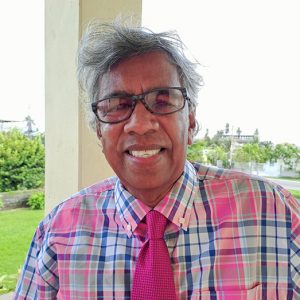THIS is the second installment in my series of social classes in Guyana as a response to the Stabroek News’ editorial on the petit bourgeoisie. The first was published yesterday. I will repeat some contents of a conference paper I did 12 years ago for the Guyana Institute for Historical Research as I go along.
In the audience was Mr. David Granger who felt that the paper was a good contribution to the elucidation of social classes in Guyana. Mr. Granger did not tell me that himself. After the conference, I went up to Beterverwagting to have a lime with Arnon Adams, the business page editor of Stabroek News and the then sports journalists of Kaieteur News, Rawle Welch and Edison Jefford.
It was Arnon who told me of Mr. Granger’s appreciation of my analysis. It was quite unfortunate that after he became president, Mr. Granger never sought to have a meeting with me to arrange for publication of my paper.
I would give anything to meet with Mr. Granger so we can talk about which section of the paper he found interesting. The paper was entitled “Class birth and class decay and in Guyana.” Guyana’s class structure before Independence consisted of a proletariat, generally founded in Georgetown, New Amsterdam and Linden.
There was a large peasantry which evolved out of the plantation system. Part of that peasantry was a Kulak class found among the wealthy, Indian, landowning stratum. The petit bourgeoisie was the descendants of the Portuguese immigrants and finally, there was a powerful middle class which emerged after Emancipation.
The play, “The Last of the Red Men,” performed last week captures the social status of that class. This class consisted of people of colour who presided over state administration, education, the professions, and the socialite sector.
In my ongoing analysis of social classes in Guyana, I refer to this class as the Mulatto/Creole class (MCC). Please see my 14-part series on the MCC in this newspaper from May to October this year.
The final social class at that time is what Karl Marx named, lumpen proletariat. This was the unemployed section that includes people in crimes and social vices. This class underwent humongous changes after the return to the capitalist system in Guyana under the Economic Recovery Programme (ERP) of President Desmond Hoyte.
The missing class in Guyana was the bourgeoisie. Guyana as a Third World plantation economy did not have a bourgeoisie until way into the 21st century. The bourgeoisie must be engaged in industrial, manufacturing, and financial capitalism to constitute a genuine bourgeois stratum.
As we go on, we will describe how the dialectics after the ERP in 1987 created a bourgeoisie and expanded the petit bourgeois and the lumpen proletariat and downsized the proletariat. Class changes move rapidly in Guyana with an oil economy providing social elevation for the proletariat contrary to the opinion of the Stabroek News.
There have been four periods that saw profound changes in Guyana’s class structure. 1- Burnhamite state hegemony. 2- Hoytean capitalist restoration. 3- Jaganite elevation of the peasantry. 4- petro-dollar economy. From the late 19 century, classes and colour interacted intricately with each other shaped by the colonial administration in Guyana.
The MCC and the petit bourgeoisie maintained an adverse stance toward both the Indian peasantry and the Indian Kulak class because of ethnicity. And though the African proletariat was despised for their dark-skin they were nevertheless favoured over the descendants of the former indentured servants.
British Guiana in the 19th and 20th century was an absorbing case in which ethnicity met class in a dangerous confluence that turned tragic in 1964 with the Wismar massacre and the Son Chapman incident. And though class crystallisation has been going on steadily since independence, the role of ethnicity still shows it large face.
The dialectic, as Hegel demonstrated, is unstoppable and one suspects that we may be entering a phase in Guyana’s class evolution in which ethnicity’s role in preserving political instability may be ebbing.
I think dialectical in class changes in Guyana may become fascinating stuff for a textbook on class and politics, where an expanding economy based on the surfeit of petro-dollars may erode the influence of ethnicity. Traditional political theory postulates that social classes endure ongoing antagonism because of scare resources. In Scandinavia, scarce resources became plentiful and that had profound changes the proletariat that proved Marx wrong.
Guyana is currently going through what Sartre wrote. Sartre brilliantly remarked that man makes the dialectics just as the dialectics make him. In my next piece, I will begin my analysis of class decay and class birth from the Burnham era and take it to the arrival of the oil industry.




.jpg)










